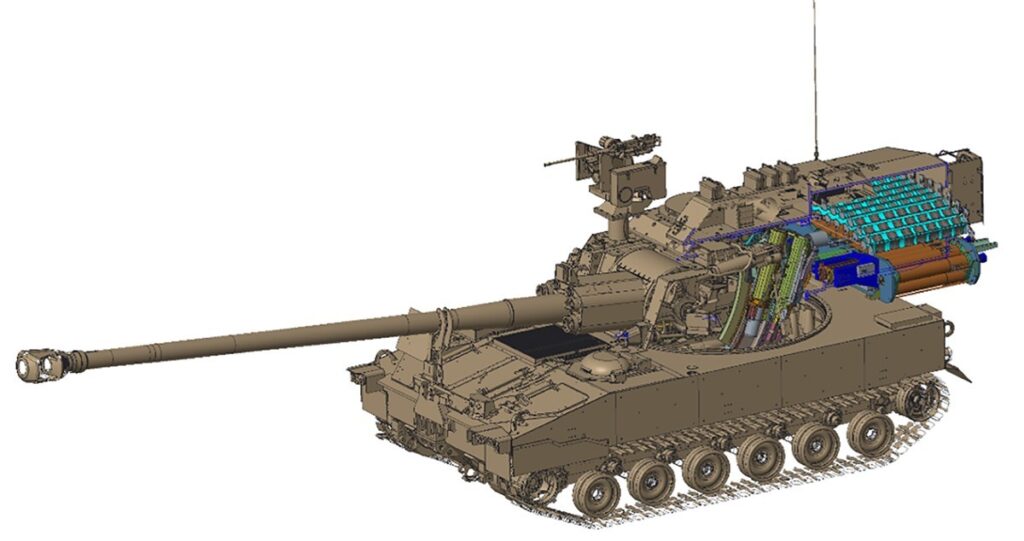The Army’s next-generation artillery system can nail targets at twice the range of the service’s existing howitzers. Now, the service’s muscular new system has a brand new name to match.
The Army officially christened the XM1299 Extended Range Cannon Artillery (ERCA) the ‘Iron Thunder’ during a ceremony at Picatinny Arsenal in New Jersey last week, according to photos posted online by the 4th Battalion, 27th Field Artillery Regiment.
The name was especially appropriate given that the Fort Bliss-based 4th Battalion, 27 Field Artillery Regiment — also nicknamed ‘Iron Thunder’ since its formation more than a century ago — will serve as the ERCA’s new operational tests unit, according to the announcement.
“Our soldiers will be the first to be trained on and employ the Army’s newest artillery capability,” the unit wrote on Facebook. “We cannot wait for these to start hitting our motorpool.”
Developed in response to increasing concerns over the growing artillery capabilities of near-peer adversaries like Russia and China, the ERCA program is one of five major programs clustered under the Army’s long-range precision fires (LRPF) initiative that’s become a major modernization priority for the service in recent years.
“The Army says that longer-range artillery systems are needed to respond to what DoD calls the enemy anti-access, area denial (A2/AD) environment (layered and integrated long-range
precision-strike systems, littoral anti-ship capabilities, air defenses, and long-range artillery and rocket systems), which can theoretically keep U.S. forces at bay and deny freedom of movement,” according to a recent Congressional Research Service report on the Pentagon’s LRPF efforts.
The ERCA has recently proven itself a formidable long-range weapon system, capable of striking a target at 43 miles (70 km) away with a salvo of M982A1 Excalibur guided artillery shells during testing in March — far outstripping the range of both the M109A7 Paladin (18 miles, or 30 km, with a rocket-assisted projectile) and the M777 (25 miles, or 40 km, with a rocket-assisted projectile) howitzers.
BAE received a $45 million contract in 2019 to integrate the new Army cannon into a standard Paladin chassis, while the ERCA will eventually incorporate a fully automated ammo loading system to boost its rate of fire from the standard 3 rounds per minute to a blistering 10 rounds per minute, a system the service started testing in earnest in December 2020.

The Army plans on fielding 18 ERCA prototypes to a battalion for operational testing by fiscal year 2023, with the effort projected to end in October 2023 “to gather information for future ERCA increments,” according to a June 2020 assessment from the Government Accountability Office.
The Army’s plan to build a fleet of ERCA systems is estimated to cost the service at least a half-billion dollars, according to the GAO assessment, which noted that the service expects the ERCA’s related technologies to be “mature upon the completion of the rapid prototyping effort in 2023.”
While the lucky soldiers with the 4th Battalion, 27 Field Artillery Regiment will get to put the ERCA through its paces over the next tears, the service plans on continuing to push the range of the supergun beyond 70 km and, in time, procure up to 77 ERCA vehicles through fiscal year 2026, according to the Congressional Research Service report.
ERCA, along with its companion long-range precision fires program, should be considered “fundamentals components of the Army’s traditional battlespace,” according to the CRS report, “and they play an important fire support role in brigade, division, and corps-level ground combat operations — a role that the Army has organized, equipped, and trained for arguably since the Second World War to present day.”
More great stories on Task & Purpose
Want to write for Task & Purpose? Learn more here and be sure to check out more great stories on our homepage.
